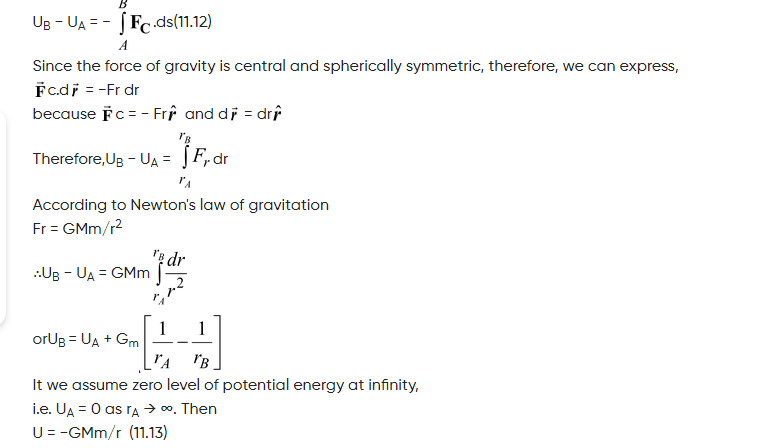

What Is Gravitational Force?
The movements of planets, stars, galaxies, and even common phenomena we encounter on Earth are all a result of gravitation, the force of attraction that exists between all masses in the universe. It is responsible for the interaction between all objects in the universe that have mass, from tiny particles to planets, stars, galaxies, and beyond.Newton’s Law of Gravitation
Newton's Law of Gravitation, formulated by Sir Isaac Newton in 1687, is one of the fundamental pr F = G (m1 m2) / r 2 inciples of classical physics. It describes the gravitational force between two objects with mass and is applicable to a wide range of everyday and astronomical scenarios. The law states that every particle of matter in the universe is drawn to one another by a force that is directly proportional to the product of their masses and inversely proportional to the square of the distance between their centres.Also Check - Energy formula
Mathematically, this law is expressed as: F = G (m 1 m 2 )/ r 2 Where:- The gravitational force between two objects is denoted by f .
- G is the gravitational constant (a fundamental constant of nature),
- m 1 and m 2 are the masses of the two objects,
- The separation between the centres of the two objects is known as r.
Also Check - Properties of Matter Formula
Gravitational Potential Energy
The formula for gravitational potential energy (U) is given by: U = m * g * h Where: - U is the gravitational potential energy (in joules, J). - m is the mass of the object (in kilograms, kg). - g is the acceleration due to gravity (approximately 9.81 m/s² on the surface of the Earth, but it can vary depending on location). - h is the height above a reference point (in meters, m). This formula represents the potential energy an object possesses due to its position in a gravitational field. The potential energy increases as the mass of the object or its height above the reference point increases.
This formula represents the potential energy an object possesses due to its position in a gravitational field. The potential energy increases as the mass of the object or its height above the reference point increases.
Also Check - Thermodynamics Formula
Examples Of Gravitational Potential Energy
Gravitational potential energy can be understood in various contexts and scenarios. Here are some different cases and examples of gravitational potential energy:- Lifting an Object: When you lift an object from the ground, you are doing work against gravity, increasing the object's height above the ground, and therefore increasing its gravitational potential energy. For example, if you lift a 10 kg box to a height of 2 meters, the gravitational potential energy gained can be calculated using the formula U = m * g * h.
- Falling Objects: As objects fall under the influence of gravity, their potential energy is converted into kinetic energy. When an object is at a certain height above the ground, it has gravitational potential energy. As it falls, this potential energy decreases, and kinetic energy increases. At the ground level, all of its potential energy is converted into kinetic energy.
- Celestial Bodies: Gravitational potential energy plays a crucial role in understanding the motion of celestial bodies, such as planets, moons, and stars. For example, the gravitational potential energy between the Earth and the Moon affects the Moon's orbit around Earth.
- Hydroelectric Power: In hydroelectric power generation, water is stored at a certain height in a dam. When the water is released and flows downhill, its gravitational potential energy is converted into kinetic energy, which is then used to generate electricity through turbines.
- Satellites and Spacecraft: In space, satellites and spacecraft have gravitational potential energy with respect to the celestial body they are orbiting. This potential energy is crucial for maintaining their orbits and performing maneuvers.
- Rock Climbing: Rock climbers use gravitational potential energy when they ascend a cliff or mountain. They store potential energy as they climb, which can be released when they descend or rappel.
- Bungee Jumping: When a person jumps off a bridge or platform with a bungee cord, they experience a change in gravitational potential energy as they fall. The bungee cord stretches, converting potential energy into kinetic energy, which slows them down before they rebound upward.
- Roller Coasters: Roller coasters are designed to exploit changes in gravitational potential energy. As the coaster climbs to the top of a hill, it gains potential energy, and as it descends, this energy is converted into kinetic energy, creating thrilling rides.
Gravitational Potential Energy Formula FAQs
What is Gravitational Potential Energy?
Gravitational potential energy is a form of energy associated with the position of an object in a gravitational field. It represents the potential for an object to do work as a result of its height above a reference point. The higher the object is above the reference point, the greater its gravitational potential energy.
How is Gravitational Potential Energy Calculated?
Gravitational potential energy (U) is calculated using the formula: U = m * g * h, where:
- U is the gravitational potential energy (in joules, J).
- m is the mass of the object (in kilograms, kg).
- g is the acceleration due to gravity (usually around 9.81 m/s² on Earth's surface).
Can Gravitational Potential Energy Be Negative?
Gravitational potential energy is a scalar quantity, meaning it can be positive, zero, or negative. It is negative when an object is positioned below the reference point. For example, if you take the reference point to be ground level, an object on the ground or in a hole would have negative gravitational potential energy.
What Happens to Gravitational Potential Energy as an Object Falls?
As an object falls in a gravitational field, its gravitational potential energy decreases, while its kinetic energy (energy of motion) increases. This is due to the conversion of potential energy into kinetic energy as the object accelerates under the force of gravity.
🔥 Trending Blogs
Talk to a counsellorHave doubts? Our support team will be happy to assist you!

Check out these Related Articles
Free Learning Resources
PW Books
Notes (Class 10-12)
PW Study Materials
Notes (Class 6-9)
Ncert Solutions
Govt Exams
Class 6th to 12th Online Courses
Govt Job Exams Courses
UPSC Coaching
Defence Exam Coaching
Gate Exam Coaching
Other Exams
Know about Physics Wallah
Physics Wallah is an Indian edtech platform that provides accessible & comprehensive learning experiences to students from Class 6th to postgraduate level. We also provide extensive NCERT solutions, sample paper, NEET, JEE Mains, BITSAT previous year papers & more such resources to students. Physics Wallah also caters to over 3.5 million registered students and over 78 lakh+ Youtube subscribers with 4.8 rating on its app.
We Stand Out because
We provide students with intensive courses with India’s qualified & experienced faculties & mentors. PW strives to make the learning experience comprehensive and accessible for students of all sections of society. We believe in empowering every single student who couldn't dream of a good career in engineering and medical field earlier.
Our Key Focus Areas
Physics Wallah's main focus is to make the learning experience as economical as possible for all students. With our affordable courses like Lakshya, Udaan and Arjuna and many others, we have been able to provide a platform for lakhs of aspirants. From providing Chemistry, Maths, Physics formula to giving e-books of eminent authors like RD Sharma, RS Aggarwal and Lakhmir Singh, PW focuses on every single student's need for preparation.
What Makes Us Different
Physics Wallah strives to develop a comprehensive pedagogical structure for students, where they get a state-of-the-art learning experience with study material and resources. Apart from catering students preparing for JEE Mains and NEET, PW also provides study material for each state board like Uttar Pradesh, Bihar, and others
Copyright © 2025 Physicswallah Limited All rights reserved.
Get App











